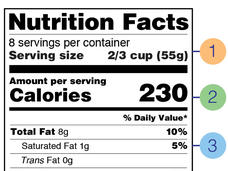, by NCI Staff
On January 1, 2020, the Food and Drug Administration (FDA) began requiring many food manufacturers to display an updated nutrition labels on their product packaging. In this interview, Robin McKinnon, Ph.D., a senior advisor on nutrition policy at FDA’s Center for Food Safety and Applied Nutrition, and Jill Reedy, Ph.D., chief of the Risk Factor Assessment Branch in NCI’s Division of Cancer Control and Population Sciences, discuss the updated Nutrition Facts label and some of the research that underpins the changes to it.
Can you explain how and why the Nutrition Facts label was updated?
Dr. McKinnon: The previous Nutrition Facts label was more than 20 years old, so it was time to make it more up to date based on new scientific information, including the link between nutrition and chronic diseases like heart disease and certain cancers. Also, the amount of food and beverages people typically eat and drink has changed, and the new label reflects that.
Dr. Reedy: The Nutrition Facts label is aligned with what we know from the science about diet and its impact on health. The label has been and will continue to be a key tool that helps consumers follow the Dietary Guidelines for Americans. So, it’s an important time to have an updated label that reflects the most up-to-date science that we have.
What are some of the major changes to the label?
Dr. McKinnon: Calories and serving sizes on the new Nutrition Facts label are in bolder and larger type, so they really stand out. Serving sizes more accurately reflect how much we typically eat and drink at one time, and the label also includes new information like added sugars. Added sugars include sugars that are added as ingredients during the manufacturing of foods. They also include single-ingredient sugars like honey, syrups, or packets of sugar, which add sugars to the diet.
The Dietary Guidelines for Americans recommend limiting calories from added sugars to less than 10% of total calories per day. For example, if you consume a 2,000-calorie daily diet, that would be 200 calories or 50 grams of added sugars per day. Consuming too much added sugars can make it difficult to meet nutrient needs while staying within calorie limits.
Are there other major changes to highlight?
Dr. McKinnon: Several. For example, for food packages that are between one and two servings, such as a 20-ounce soda or a 15-ounce can of soup, the calories and other nutrients are required to be labeled as one serving because people typically consume it in one sitting.
Consumers will also see the dual-column Nutrition Facts label for some foods that have two or three servings in the package but could be consumed in one sitting. This label has two columns, one for listing the nutrition facts related to a single serving and one listing the nutrition facts for the contents of the entire package. These changes are, in effect, “doing the math” for consumers.
Also, vitamin D and potassium are two new nutrients that people will see on the new Nutrition Facts label. They will also continue to see calcium and iron, which have been there for some time. Manufacturers no longer have to list vitamins A and C because most people get enough of these nutrients.
Dr. Reedy: Many of these changes, such as the inclusion of added sugars, tie back to the research that has been done to help understand the relationship between diet and health outcomes, including cancer outcomes.
NCI has done a lot to support research on the idea of the “total diet” which takes a more holistic approach and looks at dietary patterns rather than only individual foods or nutrients across a person’s lifespan—because we know it’s not just one thing that people eat that can affect their health, it’s the totality of their diet.
What’s known about how the “total diet” affects people’s health, including cancer risk?
Dr. Reedy: At NCI we’ve done a lot of research on this topic, with the goal of strengthening the scientific evidence base for the Dietary Guidelines. That includes the Dietary Patterns Methods Project.
In that project, we looked at key “diet quality indices,” which include the Mediterranean Diet Score; the Healthy Eating Index, which was developed to align with the Dietary Guidelines; the Alternative Healthy Eating Index; and the DASH diet, which was used in the NIH-funded DASH trial for hypertension.
We then used those indices to examine the dietary patterns of people who participated in three very large research cohorts: the NIH‒AARP Diet and Health Study, the Women’s Health Initiative Observational Study, and the Multiethnic/Minority Cohort Study of Diet and Cancer.
And we found really very similar results. Across all three cohorts, people whose diets were consistent with any of these dietary indices had anywhere from a 13% to 27% reduced risk of dying from any cause, from cancer, or from cardiovascular diseases.
We also found that, the healthier the diet, based on these indices, the greater the reduction in the risk of dying, including for cancer. And of relevance to the updated label, dietary patterns that included higher intake of added sugars were associated with an increased risk of cardiovascular disease, cancers, and other negative health outcomes.
So, we see that a healthier diet, defined by any of these dietary patterns, is associated with better health outcomes.
Do the health benefits of diet intersect with things like physical activity and exercise?
Dr. Reedy: Absolutely. Although we have been talking about dietary patterns, we also know there are interrelationships with diet, physical activity, sleep, and weight. We know that all of these things are connected. And that’s important, because we know that diet, physical activity, and obesity are linked to many cancers.
Our goal is to support and address all of these behaviors, because it’s not one or the other, it’s all of these things together. And as part of this, the new Nutrition Facts label is a great resource for the public as we work together toward helping people establish healthy dietary patterns.
Educating the Public about the Updated Nutrition Label
To help people better understand the updated nutrition label, FDA developed a comprehensive public education campaign, which includes videos and a wealth of other helpful information for consumers and health educators.










